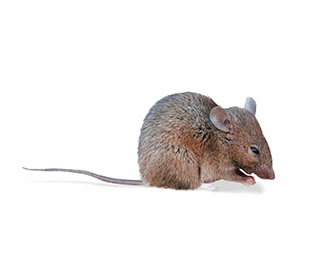© 2024 Rentokil Initial plc and subject to the conditions in the Legal statement
There are many different types of mice present in New Zealand.
One species is considered to be a major pest in this country and that is the Common House Mouse.
Field Mouse
(Apodemus sylvaticus)
Field mouse rarely venture into inhabited buildings but in the winter months, they will go into outhouses and sheds where fruit and vegetables are stored.
Field mouse are a big threat to businesses operating in farming and agriculture but is not prevalent in Australia.

Appearance of the Field Mouse
- Size: adult head and body 80 – 100mm in length; Tail 70 – 90mm.
- Weight: Male can weigh 25g, and the female 20g.
- Sandy / orange brown fur on the head and back.
- Yellowish fur on the flanks and white on the belly.
- There is usually a small streak of yellow on the chest.
Life cycle of the Field Mouse
- Their lifespan averages two to three months, but they can survive as much as 20 months in the wild, or two or more years in captivity.
- Breeding seasons are October/November to March/April and gestation lasts approximately 25 days. They grow their first fur after six days; their eyes open after 16; and they are weaned at around 18 days old.
- Survival of the young and adults is poor during the first half of the breeding season as adult males can be aggressive towards one another and to the young, who are then driven from the nest.
Habits of the Field Mouse
- They eat a high proportion of the seed crop of trees such as oak, beech, ash, lime, hawthorn and sycamore. Numbers can reach plague proportions in the grain belt areas.
- Small snails and insects are particularly important sources of food in late spring and early summer when seeds are less available.
- They also eat apples and will attack newly planted legume seeds.
House Mouse
(Mus domesticus)
House mouse are active all year round, which means you could find them invading your home or business at any time.

Appearance of the House Mouse
- Size: 70 – 95mm in length, with a tail around the same length.
- Weight: 12 – 30g.
- Their relatively small feet & head and large eyes & ears distinguish them from a young brown rat (Rattus norvegicus).
Life cycle of the House Mouse
- 4 – 16 young per litter; 7 – 8 litters a year.
- Gestation period of about 3 weeks.
- 8 – 12 weeks from birth to sexual maturity.
Habits of the House Mouse
- Usually ground living and burrowing, but often climbs.
- Preferred food is cereals.
- Will eat around 3g of food a day and can survive without any additional water. They will drink up to 3ml a day if their diet is particularly dry.
Mouse control services
Protecting New Zealand homes and businesses for over 50 years
- Safe, effective, environmentally-friendly pest control
- A broad range of mouse management options to suit your home and business needs
- With over 1,500 local, accredited pest controllers, we provide a rapid-response service across all of New Zealand